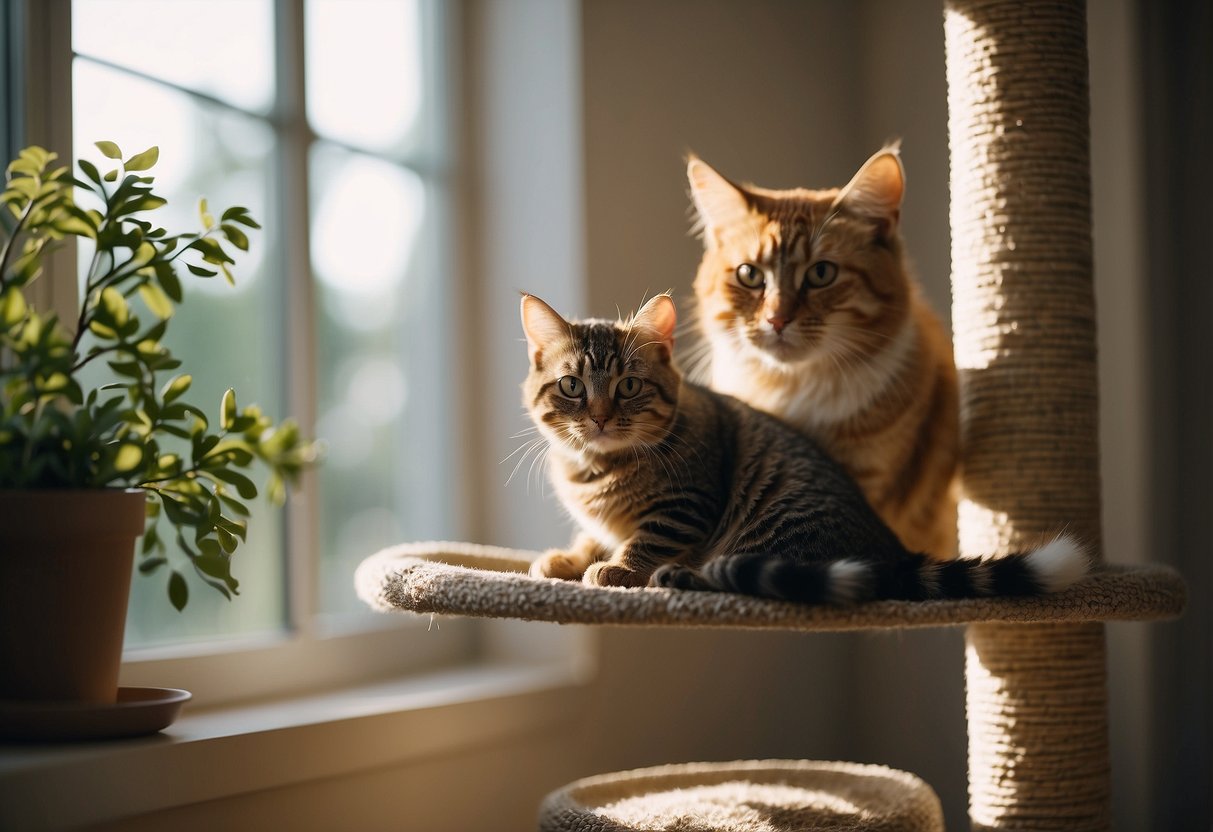Maintaining the cleanliness of your cat tree is essential for the health and happiness of your feline friend. A clean cat tree not only provides a safe and enjoyable environment for your pet to play, scratch, and rest on but also ensures the longevity of the tree itself.
Throughout my time as a cat owner, dealing with fur buildup and the occasional stain has become routine, but taking the right steps can make this task easier.

When cleaning your cat tree, a good start is to remove loose fur and debris. I’ve found using a vacuum with an upholstery attachment or a lint roller can be quite effective, especially on the areas where my furry companion likes to lounge the most.
Beyond fur, it’s crucial to address spills or accidents promptly, as bacteria can thrive in these areas. An enzymatic cleaner has been a staple in my cleaning kit as it’s designed to break down pet messes without harming the material of the cat tree.
Regularly disinfecting the cat tree is another key step, but remember to use pet-safe products to prevent any adverse effects on your cat’s health. I’ve learned to check labels for non-toxic ingredients and often use a diluted solution of hydrogen peroxide, as it’s effective against a variety of stains and odors.
Spraying and wiping down the tree with such solutions keeps the cat tree not just visibly clean but also hygienic for both your pet and your home.
Preparing to Clean Your Cat Tree

Before you tackle the task of cleaning your cat tree, readying your supplies and understanding the disassembly process are key steps. These initial preparations ensure a thorough cleanup, maintaining a hygienic and enjoyable environment for your feline friends.
Gathering Necessary Supplies
Your first step is to gather all the cleaning supplies you’ll need. Here’s a straightforward list to help you ensure nothing is overlooked:
- Gloves: Protect your hands from dirt and cleaning solutions.
- Vacuum Cleaner: An essential tool for removing loose fur and debris.
- Cleaning Solutions: Choose solutions safe for your cat and the cat tree materials.
- Microfiber Cloths: For gentle yet effective dusting and wiping down surfaces.
- Scrub Brushes: To tackle the tougher areas where fur and dirt may accumulate.
- Paper Towels: Handy for spills and spot cleaning.
Disassembling Removable Parts
Many cat trees have parts that can be easily removed, which facilitates a more efficient cleaning:
- Inspect the Cat Tree: Check for any parts that are designed to come apart, such as removable hammocks, condos, or cushioned platforms.
- Disassemble: Carefully take off these pieces according to the manufacturer’s instructions—if available—to prevent damage.
By disassembling these elements, you can access every nook and cranny, ensuring no spot is left uncleaned. Plus, it allows you to clean each part more thoroughly, whether by hand-washing or laundering, based on the materials’ resilience to water and chemicals.
Regular Cleaning and Maintenance
To maintain a clean environment for your feline friend, regular cleaning and maintenance of their cat tree are crucial. This involves routinely removing fur and dirt that accumulates over time, ensuring that all surfaces are clean, and keeping the scratching posts in good condition.
Vacuuming Excess Fur and Dirt
Begin by removing pet hair and dirt that your cat inevitably leaves behind. Vacuuming is effective for this, as it can reach into the nooks and crannies where fur likes to gather. For the best results, use a vacuum with a pet hair attachment or a handheld vacuum every week.
This helps in preventing fur from building up and becoming embedded in the fabric, making it harder to clean later.
Wiping Down Surfaces
Monthly, give the surfaces of the cat tree a thorough wipe down. Use a pet-safe cleaner and a soft cloth, ensuring you cover every surface. Pay special attention to favorite lounging spots where oils from your cat’s fur can accumulate.
If your cat tree has removable parts like cushion covers, wash them according to the manufacturer’s instructions. Always dry the components completely to prevent mold or mildew from forming.
Maintaining the Scratching Posts
Scratching posts are critical for your cat’s claw health, but they also collect a lot of debris. Regularly brush out any loose threads or materials and check for signs of wear.
If the scratching post is wrapped in rope and it starts to unravel, consider rewrapping it to extend its life. Some posts may also benefit from a light sanding to remove any rough spots that could snag your cat’s claws.
Deep Cleaning Techniques
When tackling the deep cleaning of your cat tree, focusing on stain and odor removal and thorough disinfection will help ensure a clean, safe environment for your feline friend.
Removing Stains and Odors
To remove stains and odors from your cat tree, start by identifying the affected areas. For organic stains and smells, an enzymatic cleaner specifically designed for pet odors can be effective. Apply the cleaner to the stained areas, following the product instructions, and allow it to penetrate the material, breaking down organic matter.
- DIY Solution: Mix a solution of 50% water and 50% white vinegar and apply it to the stains. Blot the area, don’t rub, as this can spread the stain.
- Hydrogen Peroxide: A diluted solution (3% hydrogen peroxide mixed with water) can help tackle various stains. Test it on a small, inconspicuous area first to ensure it won’t discolor the fabric.
- Steam Cleaning: If the cover is removable and washable, machine wash it, using a pet-safe detergent. Alternatively, steam cleaning can provide a more thorough cleanse for non-removable fabrics.
After treating the stains, let the areas air dry completely to prevent moisture from becoming trapped, which could cause mold or mildew.
Disinfecting to Prevent Bacteria and Parasites
Regularly disinfecting your cat tree is essential to prevent the buildup of bacteria and parasites that can affect your pet’s health.
- Simple Disinfectant: A mixture of 50% water and 50% vinegar can act as a natural disinfectant; spray it onto the cat tree and wipe down the surfaces.
- Hydrogen Peroxide: Use a spray bottle filled with hydrogen peroxide and lightly mist the tree to disinfect it. Avoid over-wetting as this could damage the tree or create a habitat for bacteria.
Reassembly and Post-Cleaning Care
After meticulously cleaning each part of your cat tree, it’s time to put it back together so your furry friend can enjoy their refreshed space. Remember to ensure each component is thoroughly dried and check all parts for any needed repairs to maintain a safe and comfortable environment for your cat.
Securing Components and Repairs
As you prepare to reassemble the tree, confirm every piece is completely dry to prevent mold or mildew. Start by aligning the base and gradually work your way up, securing each part with corresponding screws or bolts. If any parts appear worn or damaged, now’s a great time to perform repairs.
For instance, scratched posts wrapped in sisal rope can often be re-roped to extend the cat tree’s life. If you come across loose components, a thorough tightening of screws will help to ensure the rebuilt structure is stable and secure.
Ensuring Cat Safety and Comfort
Your cat’s safety is the top priority. Inspect all areas of the cat tree for any sharp edges or splinters that could harm your pet. If you’ve applied any cleaning agents or disinfectants, ensure they’re pet-safe and fully rinsed where necessary, as residues can be harmful.
Once the cat tree is reassembled, place it in a safe, clean area of your home to prevent re-soiling. Check that the tree is stable and comfortable for your beloved feline, confirming it won’t tip over when they leap onto it

My name is James, and welcome to FAQCats!
Along with our team of cat owners, expert pet enthusiasts, and pet professionals, we aim to write engaging helpful, engaging content about cats. At FAQCats we strive to provide content that’s accurate and fun to read. Our team writes about everything related to cats; even the most complex of topics. Through extensive research and caring for our own fur-pals, we’re able to provide something cat owners worldwide will love. Have a look around, and leave us feedback anytime!

